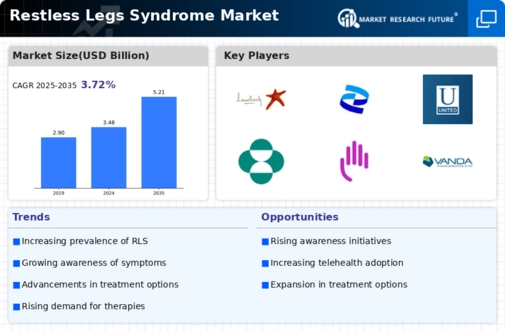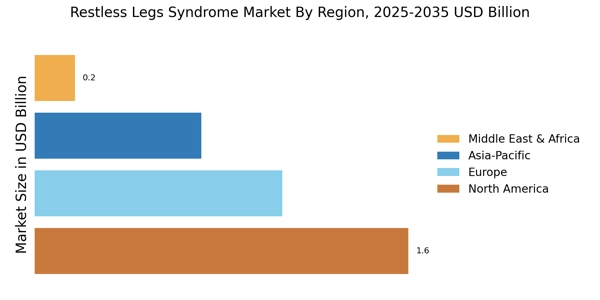Increased Focus on Sleep Disorders
The heightened focus on sleep disorders, including Restless Legs Syndrome Market, is emerging as a critical driver in the Restless Legs Syndrome Market. As sleep health gains recognition as a vital component of overall well-being, healthcare professionals are increasingly addressing RLS as a significant contributor to sleep disturbances. This shift in perspective encourages more patients to seek treatment for their symptoms, thereby expanding the market. Furthermore, the integration of sleep studies and assessments into routine healthcare practices is likely to enhance the identification of RLS cases. As awareness of the connection between sleep quality and RLS grows, the Restless Legs Syndrome Market is poised for further expansion, with an emphasis on comprehensive treatment approaches.
Innovations in Pharmacological Treatments
Innovations in pharmacological treatments for Restless Legs Syndrome Market are significantly shaping the Restless Legs Syndrome Market. The introduction of new medications, such as dopamine agonists and anticonvulsants, has provided patients with more effective options for symptom management. Recent data indicates that the market for RLS treatments is projected to grow at a compound annual growth rate of over 5% in the coming years. This growth is driven by ongoing research and development efforts aimed at improving existing therapies and discovering novel agents. As pharmaceutical companies invest in RLS research, the availability of advanced treatment options is expected to enhance patient outcomes, thereby fostering a more robust Restless Legs Syndrome Market.
Rising Prevalence of Restless Legs Syndrome
The increasing prevalence of Restless Legs Syndrome Market (RLS) is a notable driver in the Restless Legs Syndrome Market. Recent estimates suggest that RLS affects approximately 5 to 10% of the population, with a higher incidence among older adults. This growing patient population necessitates enhanced diagnostic and therapeutic options, thereby propelling market growth. As awareness of RLS expands, more individuals seek medical attention, leading to increased diagnoses. Consequently, healthcare providers are prompted to develop and offer more effective treatment modalities, which further stimulates the Restless Legs Syndrome Market. The rising prevalence is likely to continue influencing market dynamics, as healthcare systems adapt to meet the needs of this expanding demographic.
Technological Advancements in Diagnostic Tools
Technological advancements in diagnostic tools are playing a pivotal role in the Restless Legs Syndrome Market. Enhanced diagnostic capabilities, such as polysomnography and home sleep tests, facilitate more accurate identification of RLS. These innovations not only improve the diagnostic process but also contribute to increased awareness and understanding of the condition among healthcare providers. As more accurate diagnoses are made, the demand for effective treatment options is likely to rise, further stimulating the Restless Legs Syndrome Market. The ongoing development of user-friendly diagnostic devices may also empower patients to monitor their symptoms more effectively, leading to timely interventions and improved management of RLS.
Growing Demand for Non-Pharmacological Therapies
The growing demand for non-pharmacological therapies in managing Restless Legs Syndrome Market is emerging as a significant driver in the Restless Legs Syndrome Market. Patients increasingly seek alternative treatment options that complement or replace traditional pharmacological approaches. Techniques such as cognitive behavioral therapy, lifestyle modifications, and physical therapies are gaining traction as effective strategies for symptom relief. This trend reflects a broader shift towards holistic healthcare, where patients prioritize comprehensive management of their conditions. As the demand for these therapies rises, the Restless Legs Syndrome Market is likely to adapt, with healthcare providers incorporating a wider range of treatment modalities to meet patient preferences.


















Leave a Comment